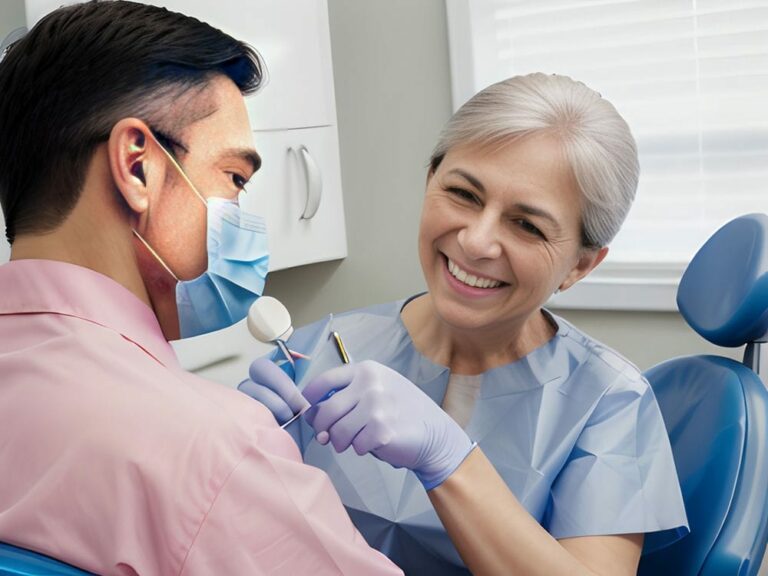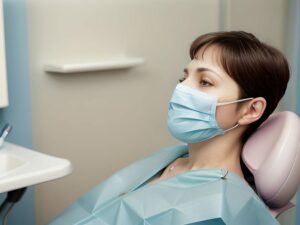Tissue Engineering in Dentistry: Revolutionizing Dental Care
Tissue engineering is a rapidly evolving field that holds great promise for revolutionizing dental care. By combining biology, engineering, and medicine, tissue engineering aims to create functional tissues and organs to restore or replace damaged body parts. In dentistry, tissue engineering techniques have the potential to transform the way we approach oral health issues and provide more effective treatments for dental conditions.
One of the key areas where tissue engineering is making significant strides in dentistry is in the regeneration of dental tissues. Traditional methods for treating tooth decay or trauma often involve filling cavities with materials like metals or composites. However, these restorative materials are not capable of regenerating the original tooth structure. Tissue engineering approaches, on the other hand, focus on promoting the growth of new dental tissues using stem cells and scaffolds.
Stem cells play a crucial role in tissue engineering by their ability to differentiate into various cell types in the body. In dentistry, stem cells derived from sources such as dental pulp or periodontal ligament can be used to regenerate damaged or lost tooth structures. These stem cells can be seeded onto biocompatible scaffolds that mimic the natural environment of teeth and guide their growth into functional dental tissues. This approach has shown promising results in preclinical studies and may soon become a viable treatment option for patients requiring oral surgery.
In conclusion, tissue engineering has tremendous potential for transforming dental care by enabling the regeneration of damaged dental tissues using stem cells and scaffolds. This innovative approach holds promise for providing more effective and long-lasting treatments for various dental conditions such as tooth decay or trauma. As research continues to advance in this field, we can expect exciting developments that will reshape the future of dentistry and improve oral health outcomes for patients worldwide.
The Role of Regenerative Medicine in Dental Tissue Engineering
Tissue engineering has not only been successful in regenerating dental tissues but has also shown great potential in the field of guided bone regeneration. This technique involves the use of biocompatible materials and growth factors to stimulate the regeneration of bone in areas where it has been lost due to conditions such as periodontal disease or tooth extraction. By creating a suitable environment for bone growth, guided bone regeneration techniques aim to restore the function and aesthetics of the oral cavity.
In addition to guided bone regeneration, tissue engineering is also being explored for periodontal tissue engineering. The periodontium, which includes the gums, ligaments, and alveolar bone surrounding the teeth, plays a crucial role in supporting dental structures. However, periodontal diseases can lead to the loss of these tissues, resulting in tooth mobility and eventual tooth loss. Tissue engineering approaches are being developed to regenerate periodontal tissues using stem cells, growth factors, and scaffolds that mimic the natural architecture of these tissues. This holds promise for providing more effective treatments for periodontal diseases and improving overall oral health outcomes.
The use of biocompatible materials is essential in tissue engineering applications in dentistry. These materials should be able to support cell growth and provide a suitable environment for tissue regeneration without causing any adverse reactions or complications. Biocompatible scaffolds play a crucial role in guiding cell attachment, proliferation, and differentiation into functional dental tissues. Researchers are constantly exploring new materials with improved properties to enhance tissue-engineering applications further.
Overall, tissue engineering is not only transforming dental care by regenerating damaged dental tissues but also holds great potential for applications such as guided bone regeneration and periodontal tissue engineering. By utilizing stem cells, growth factors, and biocompatible materials, researchers are paving the way for more effective and long-lasting treatments for various dental conditions. As this field continues to advance rapidly, we can expect exciting developments that will reshape the future of dentistry and improve oral health outcomes for patients worldwide.
Biomaterials: Building Blocks for Dental Regeneration
Dental tissue engineering is a rapidly advancing field that holds great promise for transforming dental care. One of the key factors contributing to the success of tissue engineering in dentistry is the use of biomaterials. These materials serve as the building blocks for dental regeneration, providing a scaffold for cell attachment and growth, as well as delivering bioactive molecules to promote tissue formation.
Dental biomaterials are specifically designed to be biocompatible, meaning they do not elicit any adverse reactions or complications when placed in the body. They should also possess suitable mechanical properties to withstand the forces exerted in the oral cavity. Various types of biomaterials are being explored for dental tissue engineering applications, including polymers, ceramics, metals, and composites.
In dental tissue engineering techniques, these biomaterials are often used as scaffolds to guide the regeneration of damaged dental tissues. The scaffolds mimic the natural architecture of the tissues and provide a framework for cells to attach and grow on. Additionally, bioactive molecules such as growth factors can be incorporated into the scaffolds to further enhance tissue regeneration.
As researchers continue to explore new biomaterials and refine tissue engineering techniques, we can expect exciting advancements in dental care. These advancements have the potential to revolutionize treatments for conditions such as tooth loss, periodontal diseases, and bone defects in the oral cavity. By harnessing the power of biomaterials and tissue engineering approaches, dentists may soon be able to provide more effective and long-lasting solutions for their patients’ dental needs.
Advancements in Dental Implants through Tissue Engineering
Dental tissue engineering research has made significant advancements in recent years, offering great potential for improving dental care. One area that has seen exciting developments is dental implants. Traditional dental implants have been successful in replacing missing teeth, but they can sometimes lead to complications such as infection or bone loss. However, through the application of tissue engineering techniques and biomaterials, researchers are working towards creating more advanced dental implants that can address these issues.
One of the key advancements in dental implant technology is the use of bioactive coatings on the implant surface. These coatings are designed to promote cell attachment and enhance tissue integration with the implant. By incorporating growth factors or other bioactive molecules into the coating, researchers hope to improve bone regeneration around the implant and reduce the risk of complications.
Another area of focus in dental tissue engineering research is the development of 3D-printed scaffolds for implant placement. These scaffolds can be customized to match the patient’s specific oral anatomy and provide an optimal environment for cell growth and tissue regeneration. By using 3D printing technology, researchers are able to create intricate structures that mimic the natural architecture of teeth and surrounding tissues.
These advancements in dental tissue engineering have immense potential for improving the success rate and longevity of dental implants. By enhancing tissue integration and promoting proper bone regeneration, researchers aim to develop implants that not only restore function but also maintain long-term oral health. With further research and refinement, these innovative approaches could revolutionize dental care by providing patients with more effective and durable solutions for tooth replacement.
In this way, dental tissue engineering research continues to push boundaries and explore new possibilities for improving oral health outcomes. The combination of biomaterials, such as bioactive coatings, and advanced techniques like 3D printing holds great promise for advancing dental implant technology. As scientists continue their work in this field, we can look forward to a future where tooth replacement becomes even more successful and seamless, benefiting patients worldwide.
Bone Regeneration: Restoring Jawbone Health with Tissue Engineering
Bone Regeneration: Restoring Jawbone Health with Tissue Engineering
In the field of dental tissue engineering, one of the key challenges that researchers are aiming to address is the regeneration of jawbone. In cases where patients have experienced bone loss due to trauma, infection, or other oral health conditions, restoring the jawbone becomes crucial for successful dental implant placement. Traditional techniques for bone grafting have limitations in terms of their effectiveness and potential complications. However, through tissue engineering approaches, scientists are exploring innovative solutions to regenerate jawbone and improve patient outcomes.
One promising avenue in dental tissue engineering research is the use of stem cells for bone regeneration. Stem cells have the ability to differentiate into different cell types, including bone-forming cells called osteoblasts. By combining stem cells with biomaterial scaffolds and growth factors, researchers hope to create a conducive environment for bone regeneration in the jaw. This approach has shown promising results in preclinical studies and holds great potential for future clinical applications.
Another area of focus is the development of advanced biomaterials specifically designed for bone regeneration. Researchers are exploring novel materials that can mimic the natural composition and structure of bone to promote optimal integration with surrounding tissues. These biomaterials may also incorporate bioactive molecules or drugs that can further enhance bone regeneration and prevent complications such as infection or inflammation. By harnessing the power of tissue engineering and biomaterial science, researchers aim to revolutionize the field of dental care by providing more effective solutions for restoring jawbone health.
As dental tissue engineering continues to advance, it offers a promising future for addressing the challenges associated with jawbone regeneration. Through the use of stem cells, advanced biomaterials, and innovative techniques, researchers are paving the way towards improved outcomes in dental implant placement and overall oral health. The combination of these approaches holds great promise for not only restoring lost function but also enhancing long-term oral health outcomes for patients worldwide. With continued research and development, dental tissue engineering has the potential to revolutionize dental care and provide patients with more successful and seamless solutions for jawbone regeneration.
Exploring the Potential of Tooth Regeneration in Dentistry
Dental tissue engineering offers numerous benefits in the field of dentistry, but it also has its limitations. Researchers have made significant progress in using stem cells and biomaterials to regenerate jawbone, improving outcomes for dental implant placement. The use of stem cells, combined with biomaterial scaffolds and growth factors, provides a conducive environment for bone regeneration in the jaw. This approach shows great potential in preclinical studies and holds promise for future clinical applications.
Despite these advancements, there are still challenges to overcome. One limitation is the complexity of the tissues involved in dental regeneration. The oral cavity contains a variety of tissues such as teeth, gums, and bone, each with their own unique characteristics. Creating a suitable environment for tissue regeneration requires a deep understanding of these complexities. Additionally, there may be challenges in scaling up these techniques for widespread clinical use.
However, despite these limitations, dental tissue engineering has seen success in improving patient outcomes. By harnessing the power of stem cells and advanced biomaterials, researchers have been able to restore lost jawbone function and enhance long-term oral health outcomes. With continued research and development, dental tissue engineering has the potential to revolutionize dental care by providing more effective solutions for jawbone regeneration.
Through the use of innovative techniques and cutting-edge research, dental tissue engineering offers numerous benefits for patients seeking improved oral health outcomes. While there are still challenges to overcome, researchers are making significant strides towards successful tooth regeneration and overall dental care advancements. Continued investment in this field will allow for further exploration of its potential and ultimately provide patients with more successful and seamless solutions for their oral health needs.
Dental Pulp Regeneration: Repairing and Revitalizing Tooth Nerves
Dental tissue engineering has made significant progress in recent years, particularly in the field of dental pulp regeneration. The dental pulp is the soft tissue inside the tooth that contains nerves and blood vessels. When this tissue becomes damaged or infected, it can lead to pain and even tooth loss. Traditional treatments for dental pulp damage involve removing the damaged pulp and replacing it with an artificial material. However, these treatments do not restore the original function of the tooth.
To address this issue, researchers are exploring new techniques to regenerate dental pulp using tissue engineering approaches. One promising approach involves using stem cells derived from a patient’s own body to stimulate the growth of new dental pulp tissue. These stem cells can be sourced from various tissues, such as bone marrow or adipose tissue, and then seeded onto a scaffold made of biocompatible materials.
The combination of stem cells and biomaterial scaffolds provides a conducive environment for the growth and differentiation of new dental pulp tissue. Additionally, growth factors can be introduced to further enhance tissue regeneration. This innovative approach holds great potential for fully restoring damaged dental pulp and revitalizing tooth nerves, ultimately preserving natural teeth and their functionality.
The progress in dental tissue engineering innovations has paved the way for exciting advancements in dental care. By harnessing the power of stem cells and advanced biomaterials, researchers are revolutionizing how we approach treating dental conditions like damaged or infected dental pulp. With continued research and development in this field, we can expect more effective solutions that restore oral health with improved long-term outcomes for patients.
Through ongoing investment in dental tissue engineering progress, we are unlocking new possibilities for enhancing oral health care. The innovations being explored hold great promise for improving patient outcomes by repairing and revitalizing tooth nerves through regenerated dental pulp. As research continues to advance, we can look forward to a future where dentistry is able to provide more successful and seamless solutions for a wide range of oral health needs.
Tissue Engineering Approaches for Gum and Periodontal Tissue Regeneration
Tissue engineering approaches are not only limited to dental pulp regeneration; they also hold promising potential for gum and periodontal tissue regeneration. Gum disease, also known as periodontal disease, is a common oral health issue that affects the supporting tissues around the teeth. If left untreated, it can lead to tooth loss and other complications.
Traditional treatments for gum disease include deep cleaning procedures, such as scaling and root planing, as well as surgical interventions like gum grafts. While these treatments can help manage the condition, they do not regenerate the damaged or lost gum tissue.
To address this limitation, researchers are exploring tissue engineering strategies to promote gum and periodontal tissue regeneration. One approach involves using biomaterial scaffolds to provide a framework for new tissue growth. These scaffolds can be made from materials that mimic the properties of natural gum tissue and provide structural support for cell attachment and proliferation.
In addition to scaffolds, growth factors and signaling molecules can be incorporated into the tissue engineering process to stimulate cell activity and guide tissue regeneration. By creating an optimal environment for cell growth and differentiation, researchers aim to achieve successful regeneration of gum and periodontal tissues.
By leveraging tissue engineering techniques, dentistry has the potential to revolutionize how we treat gum disease and restore oral health. The advancements in this field offer hope for more effective solutions that go beyond managing symptoms to actually promoting tissue regeneration. With further research and development, we can look forward to a future where patients with gum disease have access to innovative treatments that restore their gums’ health and functionality without resorting to invasive procedures.
Through ongoing exploration of tissue engineering approaches in dentistry, we are opening up new avenues for improving oral health care outcomes. The focus on regenerating gum and periodontal tissues holds great promise in addressing the challenges associated with gum disease treatment. As research progresses, we anticipate exciting developments that will transform how we approach oral health conditions related to damaged or lost gum tissue.
Challenges and Future Directions in Dental Tissue Engineering Research
As we continue to delve into tissue engineering applications in dentistry, it is important to acknowledge the challenges and future directions in this exciting field of research. While tissue engineering has shown promising potential for dental care, there are still hurdles that need to be overcome for its widespread implementation.
One of the main challenges in dental tissue engineering is achieving optimal integration of the engineered tissues with the surrounding natural tissues. The success of any regenerative approach relies on ensuring that the newly formed tissues can function seamlessly within the oral cavity. This requires not only mimicking the structural and functional properties of natural tissues but also promoting proper vascularization and innervation to support their long-term survival.
Another challenge lies in scaling up tissue engineering techniques for clinical use. While many promising results have been achieved in laboratory settings, translating these findings into practical and cost-effective treatments for patients remains a complex task. Standardization of protocols, optimization of manufacturing processes, and regulatory considerations are all crucial factors that need to be addressed to ensure safe and effective implementation of tissue engineering approaches in dental practice.
Despite these challenges, the future of dental tissue engineering looks bright. With ongoing advancements in biomaterials, stem cell research, and biotechnology, we can expect to see significant progress in overcoming current limitations. Collaborative efforts between researchers, clinicians, and industry professionals will play a vital role in driving innovation and bringing these cutting-edge solutions closer to reality.
In summary, while there are obstacles to overcome, dental tissue engineering holds immense promise for revolutionizing dental care. By addressing challenges related to integration and scalability, researchers can pave the way for transformative advancements in restoring damaged or lost oral tissues. Continued exploration and collaboration will ultimately lead us towards a future where regenerative therapies become an integral part of routine dental practice, improving patient outcomes and quality of life.
From Bench to Chairside: Translating Tissue Engineering into Clinical Practice
As we explore the future of dental care through tissue engineering applications, it is important to understand how these advancements can be translated into clinical practice. Moving from bench to chairside requires bridging the gap between laboratory research and practical implementation in dental clinics.
The first step in this translation process involves conducting rigorous preclinical studies to evaluate the safety and efficacy of tissue-engineered products. These studies help identify any potential risks or limitations and provide valuable data for regulatory approval. Additionally, they allow researchers to optimize manufacturing processes and fine-tune the properties of the engineered tissues to ensure optimal clinical outcomes.
Once preclinical studies have been successfully completed, clinical trials are conducted to assess the performance of tissue-engineered products in human patients. These trials involve careful monitoring and evaluation of patient outcomes, such as tissue integration, functionality, and long-term stability. The data collected from these trials not only validate the effectiveness of tissue engineering approaches but also guide further refinements and improvements.
With successful clinical trials, tissue engineering approaches can then be introduced into routine dental practice. This requires collaboration between researchers, clinicians, and industry professionals to develop standardized protocols for product manufacturing and delivery. Training programs may also be implemented to ensure that dental professionals are equipped with the necessary skills and knowledge to incorporate these innovative therapies into their practice.
By following this translational pathway, tissue engineering can become an integral part of dental care, offering transformative solutions for patients with oral tissue damage or loss. The continuous refinement of techniques and collaboration among stakeholders will drive innovation in this field, leading to improved patient outcomes and a brighter future for dental healthcare.
Through diligent research efforts and collaborative partnerships, the potential benefits of tissue engineering in dentistry can be realized on a broader scale. From laboratory discoveries to practical application at the dental chairside, this journey holds immense promise for revolutionizing oral healthcare practices worldwide without compromising quality or safety standards.
FAQs
Q: What is tissue engineering?,
A: Tissue engineering is the field of study that combines biology and engineering principles to create functional tissues and organs.,
Q: How does tissue engineering apply to dentistry?,
A: Tissue engineering in dentistry involves the development of new techniques and materials to regenerate oral tissues, such as teeth, gums, and bone.,
Q: What are the potential applications of tissue engineering in dentistry?,
A: Tissue engineering in dentistry has the potential to be used for tooth regeneration, periodontal tissue regeneration, bone grafting, and the development of biomaterials for dental implants.,
Q: Can tissue engineering be used to regrow missing teeth?,
A: Yes, tissue engineering techniques can potentially be used to regrow missing teeth by stimulating the growth of new dental tissue.,
Q: What are the advantages of tissue engineering in dentistry?,
A: Tissue engineering in dentistry offers the potential for more natural and long-lasting solutions to dental problems, reducing the need for dental implants and dentures.,
Q: Are there any limitations to tissue engineering in dentistry?,
A: Yes, there are limitations to tissue engineering in dentistry, including the complexity of recreating the intricate structure and composition of natural dental tissues.,
Q: How far along is the research on tissue engineering in dentistry?,
A: Research on tissue engineering in dentistry is still in the early stages, but there have been promising advancements and ongoing studies in the field.,
Q: Can tissue engineering be used to treat gum disease?,
A: Yes, tissue engineering has the potential to be used in the treatment of gum disease by regenerating and repairing damaged gum tissues.,
Q: What are some challenges in applying tissue engineering to dentistry?,
A: Some challenges in applying tissue engineering to dentistry include ensuring the compatibility of biomaterials, achieving proper integration with existing tissues, and achieving long-term success.,
Q: When can we expect tissue engineering to revolutionize dental care?,
A: It is difficult to predict an exact timeline, but tissue engineering has the potential to revolutionize dental care in the future as research and technology continue to advance.




















